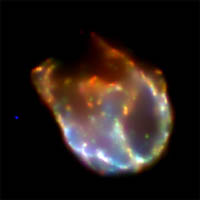The History of X-ray Astronomy:
The X-ray Universe Today

Humans have gazed at the stars for some 200,000 years. In 1610, this practice of "optical" astronomy got a nice boost courtesy of Galileo and the advent of the telescope. With just a tenfold magnification over our eyes, Galileo could see moons around Jupiter, a ring around Saturn, and craters on our own moon.
Optical telescope technology was quickly off and running, with a 350-year head start over X-ray telescopes. By 1962, when a modest X-ray detector cracked the atmosphere for a few minutes and detected extrasolar celestial X rays for the first time, hundreds of massive optical observatories dotted the globe, some high above on mountaintops, others in remote desert regions. Optical astronomers had discovered galaxies far beyond the Milky Way galaxy, each with billions of stars, as well as beautiful regions within our own galaxy.
X-ray astronomers are the new kids on the block. Yet these scientists have certainly made up for lost time, with X-ray detectors today 100 million times more sensitive than the detector that flew in 1962. At the dawn of the 21st Century, we have three complementary telescopes probing the X-ray universe beyond the solar system, as well as several observatories studying the Sun.
X-ray astronomy has become such an important field because of the phenomena in the universe that reveal themselves, sometimes exclusively, in X-ray radiation. The phenomena include star explosions, neutron stars, black holes, galaxy mergers, and interstellar and intergalactic gas clouds. Often, these objects are invisible to optical and radio telescopes, no matter how powerful the telescopes are.
Certain sources are buried in dust, impenetrable to lower-energy forms of light. The cores of star explosions, for example, remain shielded by the commotion of the explosion. Yet X rays can escape the scene, allowing us to "see" what's happening inside. Sometimes objects might be so hot or energetic that they radiate predominately as X rays. Without X-ray telescopes, we would miss many fascinating aspects of the universe.
You don't get more fascinating than the kind of stuff that the Rossi X-ray Timing Explorer observes: black holes, bursting neutron stars, and warped spacetime. Launched in December 1995, this NASA satellite is still going strong with the discovery of a new X-ray source every month, as well as major findings of black holes and neutrons stars that test general relativity. In the year 2002, in fact, the Rossi Explorer uncovered three "millisecond" X-ray pulsars. These objects are neutron stars in binary star systems spinning nearly a thousand times per second.
Scientists say that these objects are steppingstones in the evolution of a neutron star: The neutron star picks up rotational speed by pulling in matter from its companion star. The rare millisecond pulsar is a step between a slowly rotating neutron star with a companion (commonly seen) and a fast-spinning, isolated neutron star that has whittled away its companion (also commonly scene). The most recently discovered millisecond pulsar had a maligned, nearly eaten companion with a mass of only 10 Jupiters; it was originally about half the mass of the Sun (500 Jupiter masses).
The Rossi Explorer is a unique tool, excelling in timing measurements, as opposed to the imaging or spectroscopy that other satellites perform. So, the Rossi Explorer can detect rapid changes in the flow of X-ray streaming from fast-spinning objects, such as neutron stars or the gas funneling into a black hole.
One type of X-ray flickering that the Rossi Explorer detects is quasi-periodic oscillations. Scientists say these oscillations are a measure of a neutron star's spin and are best explained by Einstein's theory of general relativity. The Rossi Explorer has also observed frame-dragging, a more exotic prediction of general relativity in which strong gravity from a spinning black hole or neutron star takes spacetime along for a spin with it. Imagine matter orbiting around a black hole like children running on a merry-go-round, its orbit hastened by the shifting of the fabric of space.
NASA's Chandra X-ray Observatory and the European Space Agency's XMM-Newton satellite are like sister telescopes, launched in July and December 1999, respectively. Chandra has superb angular resolution, much like the Hubble Space Telescope. Chandra therefore excels in producing images and deciphering the structure of X-ray sources. XMM-Newton has superb collecting area and sensitivity to glean dimmer images and spectra in less time, revealing the ingredients that comprise the structure that Chandra sees.
Chandra has brought X-ray astronomy into the calendar and postcard business, a realm once reserved for optical astronomy and its lovely imagery. Chandra captures the drama of the X-ray universe with sensational images, such as that of the Crab Nebula and Vela supernova remnant. This observatory reveals structure that no telescope before it has detected in any wavelength regime.
In terms of pure science, Chandra has revealed previously undetected stellar black holes in nearby galaxies, including a possible new class of intermediate-mass black holes. Deep in the hearts of galaxies, Chandra has observed winds and X-ray jets hundreds of thousands of light years in length emanating from supermassive black holes.
Very long Chandra exposures have shown that there may be twice as many active supermassive black holes in the universe as previously thought. Chandra's unique sensitivity and precision have also enabled scientists to trace the distribution of elements such as oxygen, neon, silicon, calcium and iron in supernova remnants. And this has been just in its first couple of years of operation. Many more discoveries await us. Particularly exciting is Chandra's ability to investigate the nature of the dark matter, the mysterious matter that comprises most of the mass of the universe.
XMM-Newton has the sensitivity needed for extragalactic supernovae searches, which have been difficult previously. This satellite can also rapidly determine the temperature and the abundances of the most common elements in nearby galaxy cluster, as well as collect enough X-ray photons to resolve more distant or weaker clusters.
During its first years of operation, XMM-Newton made several key observations of supermassive black holes. Scientists could determine that supermassive black holes spin and that energy could be transported out of the black hole via magnetic field lines to the accretion disk. The magnetic field lines slowed the spin of one certain black hole as they wrapped around it. This loss of rotational energy manifested itself as brighter X rays from the accretion disk.
Also, an XMM-Newton observation of a black hole in 2002 revealed that a spectral feature called the "broad iron K line" was the result of gravity tugging back at escaping photos, stealing energy as the photons climbed out of the black hole's gravitational well. This observation supports the theory of general relativity.
Black holes, star explosions, dark matter, the big bang, and funky general relativity observations are certainly neat stuff. Scientists, naturally, want to continue our virtual journey deep into space with fantastic new X-ray telescopes. The goal is to go beyond Einstein, to understand the forces of nature that now are only partially understood and defined by general relativity and quantum mechanics.
The future of X-ray astronomy is exciting indeed, with a series of bold space-based observatories that will take us to the rim of a black hole and to the beginning of time.
40th Anniversary Articles
- Introduction
- The Rough and Tumble Early Days
- Moving Toward the Modern Era
- The X-ray Universe Today
- Forty Years from Today





